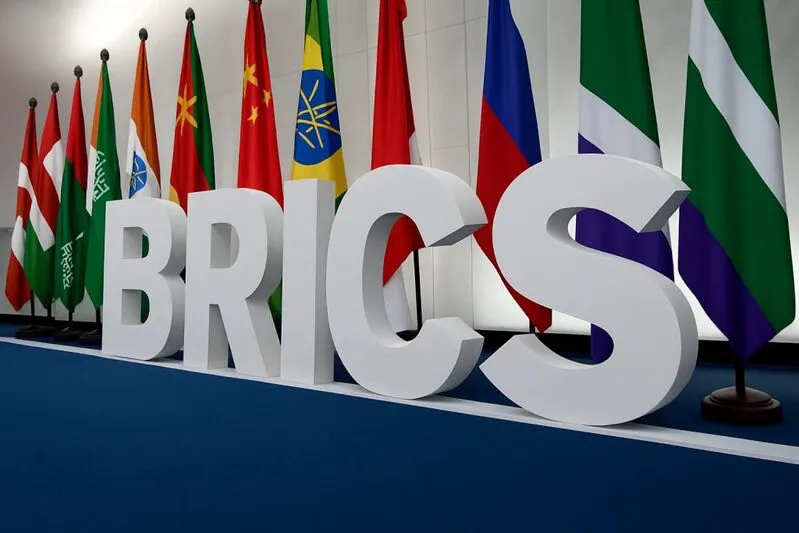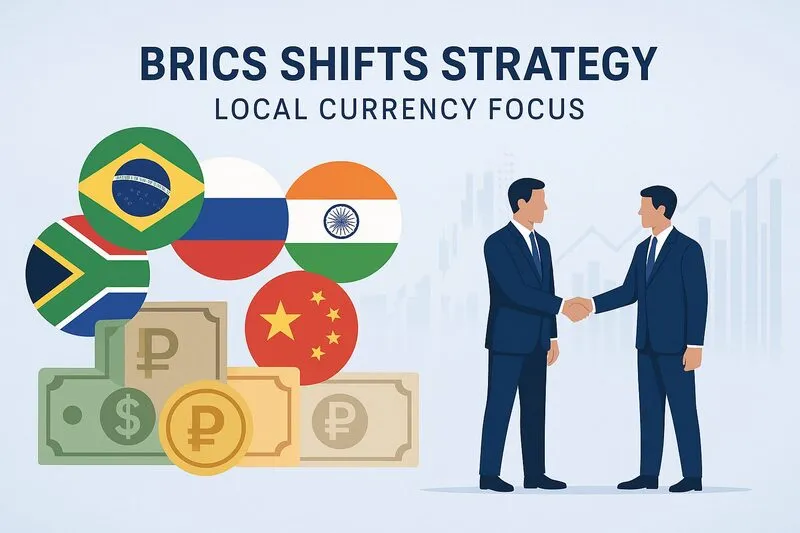The BRICS de-dollarization reversal has actually become quite apparent as member countries are now stepping back from their ambitious plans to create a unified currency that would challenge the US dollar’s dominance. Instead of pushing forward with a single BRICS currency, the bloc is right now focusing on BRICS local currency trade systems and strengthening bilateral trade relationships using national currencies.
Also Read: Tariffs Hit US Consumers Beyond BRICS Countries, Goldman Sachs Says
BRICS De-Dollarization Reversal Highlights Local Currency Trade Growth

Putin’s Changed Stance on BRICS Currency
Russian President Vladimir Putin, who was previously the biggest advocate for the BRICS de-dollarization agenda, has actually softened his position quite significantly. At the 2024 Kazan summit, Putin was seen holding what appeared to be a prototype BRICS banknote called the “Unit,” but his recent statements show a clear shift in thinking.
Putin was clear about the fact that:
“The bloc’s goal was not to break away from the US-dominated SWIFT financial system entirely, but rather to reduce the Dollar’s ‘weaponisation’ and promote the use of local currencies for trade between the BRICS members.”
Brazil Confirms No Immediate Currency Plans
Brazil, which holds the rotating BRICS presidency, has confirmed that the BRICS de-dollarization reversal means there’s no 2025 timeline for launching the unified currency. The July 2025 Rio de Janeiro summit’s 31-page declaration outlines extensive cooperation plans but actually lacks concrete currency implementation dates.
This measured approach reflects some concerns about market volatility, especially after Trump’s return to the White House caused immediate currency depreciation across BRICS nations including the Chinese yuan, Russian ruble, Brazilian real, Indian rupee, and even South African rand.
India’s Clear Position Against De-Dollarization
India has taken what appears to be the strongest stance regarding the BRICS de-dollarization reversal. MEA spokesperson Randhir Jaiswal made India’s position quite clear during a weekly media briefing.
Jaiswal stated:
“We have made our position very clear on this issue earlier as well. De-dollarisation is not part of India’s financial agenda.”
His comments came after Brazilian President Luiz Inácio Lula da Silva suggested BRICS nations could explore a trade currency amid rising tensions with the United States.
Jaiswal also added:
“India is a member of the BRICS group, and we continue to remain in touch with member countries to discuss issues of shared interest.”
Focus Shifts to Practical Solutions
This trend of the reversal of de-dollarization in BRICS has brought focus toward fostering BRICS local mechanisms. India has entered into agreements with countries like Russia, the UAE and even the Maldives to settle the BRICS in local currencies and thus help avoid the currency conversion risks. External affairs minister S Jaishankar explained that India is counting on its strategy of what he terms ‘derisking’ trade, via partner diversification and alternative payment systems as opposed to dollar independence per se.
The existing strategy focuses on launching the BRICS Pay platform and on developing the BRICS New Development Bank and on preserving financial stability of the organization. BRICS local currency trade by member countries has known that the gradualism of the regime is a more available route to sustainable change than the radicalism of taking leave of the established financial deployments.
Also Read: BRICS Is Corrupt, Leaders Deposit Billions in Swiss Bank
BRICS countries are currently focusing on bilateral trade arrangements using their national currencies and not entirely forming new fresh international currencies, which demonstrates a realistic recognition that developing alternative financial frameworks needs prudent coordination in order to prevent destabilising the international financial markets.






